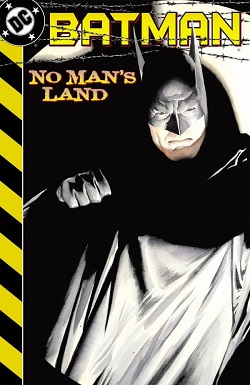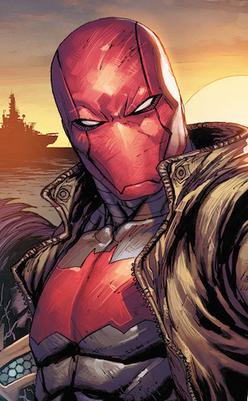
James W. "Jim" Gordon Sr. is a fictional character appearing in American comic books published by DC Comics, most commonly in association with the superhero Batman. Created by Bill Finger and Bob Kane as an ally of Batman, the character debuted in the first panel of Detective Comics #27, Batman's first appearance, making him the first Batman supporting character ever to be introduced.

Lucius Fox is a character appearing in American comic books published by DC Comics, commonly in association with the superhero Bruce Wayne / Batman. He is Wayne's business manager at Wayne Enterprises who runs the business interests that supply his equipment needs as well as financing his operations, and is the father of Luke Fox / Batwing, Tiffany Fox / Batgirl, and Jace Fox / Batman.

Jason Peter Todd is a character appearing in American comic books published by DC Comics. First appearing in Batman #357 in March 1983, he was created to succeed Dick Grayson as Robin, Batman's partner and sidekick. He initially shared a similar origin to Grayson, being the son of circus acrobats who are killed by criminals in Gotham and adopted by Bruce Wayne/Batman as his son and protege. Following the Crisis on Infinite Earths event and the rebooting of DC's main comics universe, Jason's origin was changed to being a pre-teen street urchin and petty thief who Bruce adopted and took under his wing after finding the boy attempting to steal the tires off of the Batmobile. This origin has since become the standard for subsequent iterations of the character.

The Bat-Signal is a distress signal device appearing in American comic books published by DC Comics, as a means to summon the superhero, Batman. It is a specially modified searchlight with a stylized emblem of a bat affixed to the light, allowing it to project a large bat symbol onto cloudy night skies over Gotham City.

Black Mask is a supervillain appearing in comic books published by DC Comics. Created by Doug Moench and Tom Mandrake, the character debuted in Batman #386. He is commonly depicted as a brutal and ruthless crime lord in Gotham City who has a fixation with masks and derives sadistic pleasure from the act of torture. Black Mask is one of the most enduring enemies of the superhero Batman and belongs to the collective of adversaries that make up his rogues gallery.

"Batman: No Man's Land" is an American comic book crossover storyline that ran for almost all of 1999 through the Batman comic book titles published by DC Comics. The story architecture for "No Man's Land" and the outline of all the Batman continuity titles for 1999 were written by cartoonist Jordan B. Gorfinkel.

Hush is a supervillain appearing in American comic books published by DC Comics. Created by Jeph Loeb and Jim Lee, the character first appeared in Batman #609 in January 2003 as part of the twelve-issue storyline Batman: Hush. Hush serves as a criminal foil to the superhero Batman and belongs to the collective of adversaries that make up his rogues gallery.

The Red Hood is an alias used by multiple characters appearing in American comic books published by DC Comics. The identity was first used in the 1951 story line "The Man Behind the Red Hood!", which provides the earliest origin story for the Joker. The storyline depicts an unnamed criminal wearing a red dome-shaped hood who, after a chance encounter with Batman, is disfigured by chemicals and becomes insane, giving birth to his future Joker persona.

Nora Fries is a character appearing in American comic books published by DC Entertainment. She was created by Paul Dini and Bruce Timm for Batman: The Animated Series, in which she is depicted as the terminally ill wife of Dr. Victor Fries, who cryogenically freezes her and becomes the supervillain Mr. Freeze to find a cure for her condition. Nora is later adapted into the mainstream comic book canon and revived as a supervillain under the aliases Lazara and Mrs. Freeze.

Thomas Alan Wayne, M.D. is a fictional character appearing in American comic books published by DC Comics. He is the father of Bruce Wayne (Batman), and husband of Martha Wayne as well as the paternal grandfather of Damian Wayne. Wayne was introduced in Detective Comics #33, the first exposition of Batman's origin story. A gifted surgeon and philanthropist to Gotham City, Wayne inherited the Wayne family fortune after Patrick Wayne. When Wayne and his wife are murdered in a street mugging, Bruce is inspired to fight crime in Gotham as the vigilante Batman.

Martha Wayne is a fictional character appearing in American comic books published by DC Comics, commonly in association with the superhero Batman. She is the mother of Bruce Wayne (Batman), and wife of Dr. Thomas Wayne as well as the paternal grandmother of Damian Wayne, the fifth Robin. After she and her husband are murdered in a street robbery, her son becomes inspired to fight crime as the vigilante known as Batman.

In addition to DC Comics books, the superhero Robin also appears in other media, such as films, television and radio. Dick Grayson, Jason Todd, Tim Drake, Stephanie Brown, and Damian Wayne are examples of the characters who use the name Robin.

Batman and Robin is an American comic book ongoing series, created by Grant Morrison and featuring Batman and Robin. The debut of the series followed the events of "Batman R.I.P.", Final Crisis, and "Battle for the Cowl" in which the original Batman, Bruce Wayne, apparently died at the hands of DC Comics villain Darkseid and features the winner of the "Battle for the Cowl" as the new Batman. The conclusion of Battle for the Cowl shows Dick Grayson ascending to the role of Batman, while Damian Wayne becomes the new Robin.
Catwoman is a fictional character first appearing in issue 1 of the Batman comic book. After her debut she would appear in many forms of media including live-action and animated film, radio, live-action and animated television, records, video games, web series, live performance, and podcasts. The character has made live-action appearances in the Batman television series (1966–68), its film adaptation Batman (1966), Batman Returns (1992), Catwoman (2004),The Dark Knight Rises (2012), Gotham (2014–19), and The Batman (2022). The character has also appeared in numerous animated television series and movies, most notably Batman: The Animated Series (1992–95) and The Lego Batman Movie (2017), as well as video games such as the Batman: Arkham series.

Batman: Curse of the White Knight is an American comic book published by DC Comics under its Black Label imprint. The eight-issue limited series, written and illustrated by Sean Murphy, began publication on July 24, 2019 and concluded on March 25, 2020. It is the sequel to Batman: White Knight and is the second installment in the Murphyverse's White Knight series, which takes place within a self-contained alternate reality that is different from and unrelated to the main DC Universe.

The Riddler, a supervillain in DC Comics and an adversary of the superhero Batman, has been adapted into numerous forms of media, including feature films, television series, and video games. The character has been portrayed in live-action by Frank Gorshin and John Astin in the 1960s television series Batman, Jim Carrey in the 1995 film Batman Forever, Cory Michael Smith in the 2014 Fox series Gotham, and Paul Dano in the 2022 film The Batman. Actors who have voiced the Riddler include John Glover in the DC Animated Universe, Robert Englund in The Batman, and Wally Wingert in the Batman: Arkham video games.

Duke Thomas is a fictional character appearing in comics published by DC Comics. He was created by Scott Snyder and Greg Capullo. He was introduced as a supporting character of Batman, his first appearance being in 2013 in Batman #21, before later leading a youth vigilante movement inspired by Robin, in the comic book We Are... Robin, in May 2015. He officially became Batman's newest partner and joined the Batman family in 2016.

Bruce Wayne, also known by his vigilante persona Batman, is a fictional character who is the main protagonist in Christopher Nolan's trilogy of superhero films, based on the DC Comics character of the same name, created by Bill Finger and Bob Kane. Portrayed by Christian Bale, this version of Batman is arguably explored more in-depth compared to that of the previous film series by Tim Burton and Joel Schumacher, as the Dark Knight film series provides a full arc for the character and was intended by Nolan to be more realistic than previous portrayals.
"The Joker War" is a comic book crossover storyline published by DC Comics in late 2020, featuring Batman and his allies. Primarily written by James Tynion IV, the arc is his first major arc on Batman in DC Rebirth. The main story was from Batman #95–100, while 16 other issues were tie-ins.

Mr. Freeze, a supervillain in DC Comics and an adversary of the superhero Batman, has been adapted in various forms of media, including films, television series, and video games. The character has been portrayed in film by Arnold Schwarzenegger in Batman & Robin (1997), and in television by George Sanders, Otto Preminger, and Eli Wallach in the 1966 Batman series, and Nathan Darrow in Gotham. Michael Ansara, Clancy Brown, Maurice LaMarche, and others have provided the character's voice in animation and video games.




















